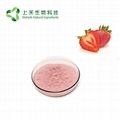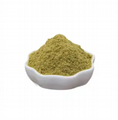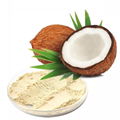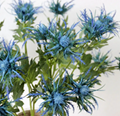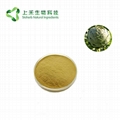| Model: | - |
|---|---|
| Brand: | Changsha Staherb |
| Origin: | - |
| Category: | Agriculture & Foods / Agricultural Products & Resources / Plant Extract |
| Label: | - |
| Price: |
-
|
| Min. Order: | - |
Product Description
Baobab extract not only has moisturizing effect, but also antioxidant effect and increase skin elasticity effect, it has the effect of nourishing stomach and bile, clearing heat and swelling, stopping bleeding and diarrhea and calming effect, and has the property of inhibiting cancer cells. It can also be used to make refreshing drinks and condiments, and is a natural and healthy food and beverage additive, as well as a natural raw material for health care products. It has a wide range of applications in food, beverages and medicine.
Source Plant: Baobab is the "oldest" in the plant kingdom, generally living 4000-6000 years. The tree has a spectacular shape, the fruit is as big as a soccer, sweet and juicy, and is a very popular food for monkeys and orangutans. The baobab has provided life-saving water for many people traveling in the savanna, saving travelers whose lives were in danger due to thirst, hence the name "tree of life". If you are thirsty in a desert with baobab trees, you don't have to use your "reserves", just dig a hole in the belly of the baobab with a knife, and the sap will gush out like a fountain, and then you can drink. The baobab tree lives with life, and as long as it is there, there is nothing to worry about when traveling in the desert. During the great famines of African history, the baobab fruit, the "natural bread", saved the lives of thousands of starving people.
Alias: Baobab tree, monkey wood.
The baobab tree is one of the oldest and most unique tree species on earth, native to tropical Africa, from the African continent, the Mediterranean, the Atlantic and Indian Ocean islands, to northern Australia, can be seen baobab, in China, Fujian, Guangdong, Yunnan tropical areas also have a small number of cultivation. In the Mulundava region of Madagascar in the Indian Ocean, most of the world's breadfruit species are concentrated, and it is the most famous spot for viewing baobab trees.
Plant Form] Deciduous trees. General tree height of about 20m, in the origin of some up to 35m; trunk base expansion, generally 6 to 9m in diameter, individual single plant up to 12m, for the short and stubby trunk. The main trunk is short, palmately compound, set at the ends of branches, leaflets usually 5, entire, rectangular-obovate, petiole 10-20cm long, leaves abaxially sparsely stellate pilose. Flowers large, bisexual, solitary or paired in the leaf axils at the top of branches, pendulous, bracts 2; calyx leathery, 5-parted; petals 5, white and rugose, beautifully fragrant, basally connate, adnate to the base of the staminal tube; stamens numerous, filaments connate into a tube; ovary superior, 5-10(-15) cells, ovules numerous. Fleshy fruit long ellipsoid. Seeds black.
Active ingredients: Baobab trunk leaves contain 13% to 15% protein, 60% to 70% sugar, about 11% cellulose, 16% ash and 4% to 10% oil. The energy value is 11800 to 19000kJ/kg, 80% of which can be used for its own metabolism. The dried leaves are also rich in beta carotene and primary production of vitamin A. The young leaves contain 4% protein and are rich in vitamin A and vitamin C. The leaves of baobab are rich in mineral nutrients such as calcium, iron, potassium, magnesium, manganese, molybdenum, phosphorus and zinc. The mature fruits of baobab tree contain an average of 8.7% water, 2.7% protein, 0.2% fat, 73.7% sugar, 8.9% fiber and 5.8% ash, and the pulp is rich in vitamin C, which is almost 10 times the content of oranges. The seeds contain 50% more energy than the leaves, with an energy value of 18030kJ/kg. The seeds contain 33.7% protein, 30.6% fat, 4.8% sugar, 16.9% cellulose and 5.9% ash. The seeds contain vitamin B1 and vitamin C.
Ecological adaptability: Baobab is a temperature-loving tropical tree species that can tolerate a maximum average temperature of 40°C and above, and an extreme minimum temperature of 0°C. Frost has a large impact on the tree, with an annual average temperature of 20-30°C in its natural distribution area. The tree is extremely drought tolerant, with annual precipitation of 300 to 800mm in the suitable area, and poor growth in hot and humid climates or with annual precipitation of 1000mm or more. It is commonly found at altitudes of 450-600m, but at altitudes of 1,000-1,500m in the distribution area of the Chemicalbookseobia and its margins. It is extremely resistant to drought and fire, reducing water consumption by defoliation in the dry season, for example, and the seemingly elephant-bark bark can regenerate after fire damage. Therefore, baobab is not suitable for growing in hot and humid areas with frost and tropical rainforest climate characteristics.
Uses1.CosmeticsBaobab extract not only has moisturizing effect, but also has antioxidant effect and increase skin elasticity effect drugs, has stomachic and choleric, clearing heat and swelling, stopping bleeding and diarrhea and calming effect, and has the property of inhibiting cancer cells.2.Food and beverageBaobab extract can make refreshing drinks and condiments, and is a natural and healthy food and beverage additive ingredient natural raw materials for health products. The young leaves of baobab can be used as a vegetable to prepare dishes or for making various salads, soups, sauces and ingredients, and the leaves can be dried and ground into powder for trading in the market as raw material for making sauces or food. The fresh and dried pulp can be eaten directly or used to cook porridge and make wine and beverages. The seeds can be snacked on raw or used as a thickening agent in soups, as a flavoring agent and after roasting. Baobab seeds can be refined into edible oil, and its protein content is significantly higher than that of vegetable oils such as peanuts.3. Medical uses Baobab has a wide range of applications in modern medicine. The leaves can be used to produce antipyretic drugs and to treat cancer and heart disease. West Africans dry the leaves of baobab to make powder, which is used to cure many diseases, such as kidney and bladder diseases, asthma, fatigue, abdominal pain, tumors, diarrhea, trauma, insect bites and inflammation. The pulp also produces antipyretics and prevents dysentery, promotes sweating, can be used to treat Newcastle disease in poultry, and the pulp has been used to treat measles and smallpox. The bark is most widely used as a substitute for quinine to prevent colds, treat toothaches, fevers and dysentery, and in Madagascar baobab bark is used as a painkiller and to treat diabetes, polyuria and other diseases. The seeds can prevent diarrhea and hiccups, and the vegetable oil extracted from the seeds can be used to treat inflammation and relieve toothache. The roots are pounded into powder form to treat malaria. In addition, the bark, pulp and seeds contain antidotes to poisoning by poisonous hairy spinneret species. In East Africa, the bark can be made into an antidote for arrow poisoning. In Malawi, the sap of baobab is poured over the wounds of animals killed in this way before eating the poisoned animals, thus neutralizing the poison.4. Other uses Baobab contains fibers and the bark can be made into various ropes, strings for musical instruments, baskets, fishing nets and packaging materials, used to cover roofs, make shoe soles, clothes, hats, bags, mats, etc. It is a widely utilized textile fiber. In East Africa, the bark is also used to make red dye or as a coloring agent for decorative items. The husk of the fruit is used to produce tobacco and can be carved into a variety of long-handled spoons and containers. In Nigeria, the leaves are a common ingredient in horse feed, and are added to feed to strengthen horses. In Zimbabwe, the soaked roots are used to bathe children for smoother skin, and the roots can be made into decomposable fuel. The seed oil can be used to treat skin problems and to some extent it is also used for cosmetic purposes, and the hard seed husk can be used to produce utensils for food and water. Pollen can be used to make glue. Wood pulp can be used to produce writing paper.
Prospects for product development: Baobab is widely used in food, beverage, medicine, weaving, textile and daily utensils and handicraft products, but its industrial development is still in the initial stage, and the product market is more regional, mainly in tropical African countries and regions, and the added value of the products is not high. In the past 10 years, baobab series products have been developed by Europe and India, and it is expected to take the lead in industrialization in the production of health food, beverage and pharmaceutical products. Baobab is generally used as an ornamental plant in China, and the number is small and scattered, so it does not have the resources for industrial development.
Efficacy: It is used for anti-inflammatory, antipyretic and malaria treatment, with stomachic and choleretic, detoxifying, hemostatic and sedative effects.
Company Introduction
Address: Room 202, Building B8, Huanchuang Enterprise Square, Lugu Street, Yuelu District, Changsha City, Hunan Province
Website: http://www.staherb.com/
Business scope: Biotechnology, research and development of plant extracts (can be used in the field of pharmaceutical and health products, cosmetics, feed additives and biological pesticide production and development)
Main products: Eucommia extract - chlorogenic acid (5%-98%), ursolic acid (25%-98%), corosolic acid (1%-98%), bitter amygdalin (50%-98%), epimedoside (10%-98%) and other standardized high-purity plant extracts.
If you wanna know more about us, please feel free to contact me at:
Whatsapp: +86 13548561509
Email: staherb18@staherb.cn
or you can send me online message if it's convenient for you.
We look forward to cooperating with you!
Member Information
| Changsha Staherb Natural Ingredients Co., Ltd., | |
|---|---|
| Country/Region: | Hu Nan - China |
| Business Nature: | Manufacturer |
| Phone: | 18975842720 |
| Contact: | Yoland (sales) |
| Last Online: | 10 Jan, 2025 |



